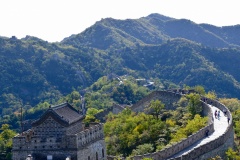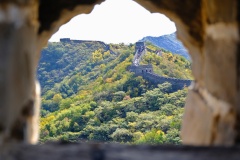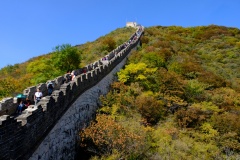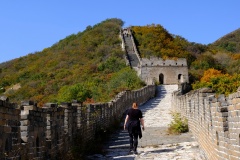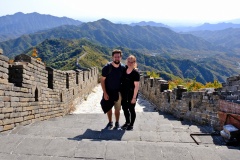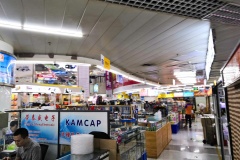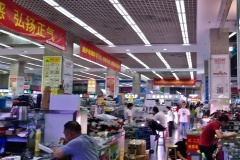Although we left China over a month ago I felt the need to do one last post to briefly cover the food, people, politics and cities we visited in China. I feel like you could spend years in China without getting to grips with this vast and varied country. Our three week hop through some of the cities of China barely scratches the surface what one can experience, however, my understanding of this country has changed significantly.
My naive and ignorant views of an underdeveloped country that has yet to catch up with the rest of the world couldn’t be further from the truth. In fact Shenzhen is the most developed and modern city I have ever visited and travelling 600 km in 3 hours in a bullet train feels like being in the future. China is steamrolling into its position as the global superpower and this is abundantly apparent in its hustling, bustling and vibrant cities.
Politics
However, before I get into our experience of the people and culture of China I would like to briefly discuss the politics of China. I struggled with whether or not to include this because I believe its not fair to judge a country’s people by the behavior of its government, especially when its people have little to no control over its behavior. I felt the need to put this post in this context as it is impossible to separate my experience of China from the evils of its government. I found myself constantly wondering; are the Chinese people completely unaware of these atrocities or do they willingly ignore them? I believe the truth lies somewhere in the middle.
I am diametrically opposed to the Chinese government and therefore was very curious about the people who seem to support this government. I am acutely aware of the atrocities inflicted by the Chinese government on the Uyghurs. At least 120,000 (and possibly over 1 million) Uyghurs are detained in mass detention camps in China. Reports of organ harvesting of these prisoners combined with recent events in Hong Kong are all too reminiscent of Nazi Germany. While I have not gained any insights into this from my trip to China, I felt compelled to include it all the same.
Unimaginable Scale
Its also impossible to explain the strange and wonderful world of China without putting it in the context of its enormous scale. Scale of population, economy and landmass. China is home to almost a fifth of the world’s population. Forty years of economic growth, at an average of nearly 10% a year, has transformed the country into a global leader in technology and manufacturing. According to the World Bank, more than 850 million Chinese people have been lifted out of extreme poverty; China’s poverty rate fell from 88 percent in 1981 to 0.7 percent in 2015. Its not hard to see why the Chinese have such pride in their country and government.
The People
Now that the bigger picture of China is out of the way, I can talk about our experiences of the people of China. External tourism, with the exception of places like Beijing or Shanghai, is almost non existent in China; we met maybe three people on our entire trip who spoke English. This meant that our interaction with the people was unfortunately very limited. Without the opportunity to talk with the locals we were presented with a somewhat superficial impression of the people.
Curious
This trait is perhaps not just Chinese but it was something we noticed a lot, especially with kids. On one occasion in Nanning, we went to a park for a run where there were many groups of kids around 10 years old. Upon seeing us we were met with a chorus of “Hello! Hello! Hello!”. Some even approached and asked “Where are you from?” or “What’s your name?”. It was really refreshing to see kids express their curiosity so openly. They seemed eager to practice their English. While there may not be many English speakers in China today, I am confident that this will change drastically in 10 years.
Staring
It seems as we get older we are less open about our curiosity, but we don’t lose it. Through much of our trip we felt very much so like celebrities. Our first experience of this was when we arrived in Qingdao by ferry from South Korea. Aside from this being the home of Tsingtao beer, there is little to attract western tourists here. This was apparent in the level of attention we received; people would stare unashamedly at us as we walked past. Presumably we looked like some kind of milky giants. This trend continued throughout our journey through China. This, while understandable, proved to be an exhausting experience.
Better Out, Than In
We were also quickly introduced to a habit of the Chinese people, spitting. Spitting, a practice seen as rude and disgusting by most westerners, is perfectly acceptable behavior in China. This is a good example of a stark difference in culture that is astounding to both sides. Apparently the thinking in China is that it is simply better out than in. It is equally perplexing for them that we don’t spit.
Skyping
Another aspect of the fascination with us was an unexpected invasion of privacy that happened twice while riding the bullet trains. A woman, sitting next to Mirjam, while skyping her friend, turned the phone directly towards Mirjam, presumably to show her friend this strange white alien sitting beside her.
Elderly Excersize
Chinese people like to keep active, especially into old age. This is not unique to China, in fact it seems to simply be something lacking from western culture. If you go to a park in China you will surely find people running, dancing and exercising. I noticed that most of these people were elderly and much of their exercise was focused on stretching. We have a whole post on this here.

Nakedness
I believe that everyone should feel comfortable naked. Having said that I certainly don’t and I believe most Irish don’t either, or Swiss for that matter. Somehow we have thought ourselves that nakedness is wrong, the Chinese, it seems, have not. I didn’t experience this personally but Mirjam did. We went to the gym in Xi’an and afterwards Mirjam told me how in the Women’s dressing room they had no qualms about being naked.
The Food
What is Chinese food? That’s a huge question that might not even have an answer. What do one fifth of the global population eat? The simple answer is a huge variety of things. But the food we had was noodley, spicy, meaty, fragrant and, for the most part, delicious. Rather than answer the question I have picked three meals that stood out. These dishes brought my understanding of good food to a new level. A form of culinary enlightenment if you will.
Twice Cooked Pork Fried Noodles
We found the place that serves what I consider the best dish of our entire trip with the help of a famous youtuber called thefoodranger in a place called Shangchi Mianguan in Chengdu. The restaurant was messy and dirty and full of locals. This, by the way, is a sign of a good place to eat. In China, presentation and service is not a priority, it’s all about the food. To be completely honest they could have served this dish by flinging it at my head and I would have been happy. It was intensely spicy and the twice cooked pork was wonderfully tender.

Peking Duck
When in Beijing, AKA Peking, we naturally had to try the famous Peking duck. We arranged to meet with Brid, Hubert and Shane, whom we had met in Seoul, at a restaurant called Jingzun Peking Duck Restaurant. Peking Duck is roast duck with a very crispy skin that has been marinated in a sweet and spicy sauce. It is served with thin crepe like pancakes, spring onions, hoisin sauce and sugar. Perhaps the most decadent food I have ever eaten. Dipping the crispy fat into sugar felt so wrong and so right at the same time.

Xi’an pulled noodles
The city of Xi’an is famous for its street food and its pulled noodles. Once again we followed the advice of thefoodranger to find the best place to try the noodles. We found Liuxiang noodles as per his advice. It was a big place full of locals. They were however well prepared for tourists, they knew exactly what we wanted. The thick juicy noodles were delicious. I was left with watery eyes after slurping these down.

The Cities
Our trip through China was almost completely in Cities. We started in Qingdao where our boat from South Korea landed. From there we took a series of trains to Beijing, Xi’an, Chengdu, Guilin, Schenzen, Hong Kong, Nanning and finally Pingxiang. I will only give a very brief outline as it is getting late and I am lazy.
Qingdao
Population: 9.046 million
We went to Qingdao because it was where our boat landed. We didn’t do any research before arriving. The first thing we noticed here was the smog. An unfortunate first impression of China. I experienced quite a culture shock as I was not expecting the constant staring, cars beeping horns, cameras everywhere and general chaos that is a city in Asia. After settling in we realized this was the home of Tsingtao beer. We went to the “beer street” beside the Tsingtao beer museum and had a few beers, naturally.
Beijing
Population: 21.54 million
After a 3.5 hour, 670 km journey on a bullet train we arrived in Beijing, the capital of China. Beijing was much more developed than Qingdao. There was also much less staring here as external tourism is normal in Beijing. The main highlight was meeting Hubert, Shane and Brid for peking duck and going for drinks after. The low light was watching Ireland getting trashed by New Zealand in the RWC quarter finals.
Of course we also visited the Great Wall of China near Beijing at Mutianyu. Without going into too much detail it was well worth the visit. We got there as early as possible to beat he crowds. It was both a somewhat challenging hike and an amazing spectacle.
Xi’an
Population: 12 million
To get to Xi’an we decided to take the night train as it was much cheaper. This was a roughly 13 hour trip. It was clearly a trip not many tourists took as the passengers were somewhat surprised to see us. One very kind woman with good English approached us and very kindly offered help with ordering food. The food cart was regularly pushed up and down the narrow aisle just outside the beds. Sitting on top of it was a megaphone, blaring out something in Chinese, presumably announcing what was available for sale.
The highlight of Xi’an was the food, especially the street food. The Xi’an muslim quarter hosted a big street food market every night that was a sight to behold. Spicy fried tofu, fried squid on a stick, soup noodles, pulled noodles, BBQ chicken, durian fruit, spicy new potatoes, tokoyaki; the list is endless. Its overwhelming, an overload of every sense.
Another famous attraction in Xi’an is the famous Terracotta Army. The Terracotta Army is a collection of terracotta sculptures depicting the armies of Qin Shi Huang, the first Emperor of China. It is a form of funerary art buried with the emperor in 210–209 BCE with the purpose of protecting the emperor in his afterlife.

Chengdu
Population: 14.43 million
Another bullet train, about 4 hours and 650 km later and we were in Chengdu. This city has a very western feel to it for some reason. There are a large number of fortune 500 companies with offices in Chengdu so perhaps there is a lot of expats here. We stayed for a few nights. The main attraction was certainly the Chengdu Panda Research center. Have a look at our dedicated post on the Giant Pandas here.
We also got a chance to see the Chengdu Opera which includes the very famous mask changing act.
Guilin
Population: 4.748 milion
Yet again a ride on the bullet train brought us to Guilin. We didn’t see much of the city itself as we used it as a base to explore the nearby rice terraces and Li river. Again, we have a dedicated post on this topic so follow this link if you want to read more.
Shenzen
Population: 12.53 million
Shenzhen is arguably the electronics capital of the world and is situated just across the hills from Hong Kong. How it came to be this way is quite interesting. In May 1980, the Central Committee designated Shenzhen as an SEZ, an experimental ground for the practice of market capitalism. The population of Shenzhen in 1980 was around 60,000 and has now grown to a whopping 12 million!
Unfortunately, while in Shenzen we got sick and were out of action for two days. However, we did get a chance to visit the famous Huaqiangbei electronics markets. These markets are dense open plan buildings filled with vendors representing various electronics manufacturers and shops.
To give an example of how this works, imagine a CCTV system. In Huaqiangbei you can find a whole floor dedicated to CCTV systems. At the front are vendors selling complete CCTV cameras. Behind that you might have vendors selling IR modules, CMOS sensors, casings etc. Behind that again you would find vendors selling IR module components. On one floor you can find the whole supply chain for CCTV cameras. These vendors might have small shops, but they are ready to take huge orders and start shipping parts to your business.
Hong Kong
Population: 7.392 million
Due to the protests in Hong Kong we were always uncertain as to the safety concerns as a tourist. We kept an eye on the events as they unfolded and decided that it was safe enough to travel. Sure enough when we arrived in the city, you would be forgiven for thinking it was business as usual. The only signs of the protests were the graffiti all over some of the streets.
While in Hong Kong we stayed in the famous/infamous Chungking Mansions. This building, originally intended as a block of cheap apartments, has since been converted into cheap guesthouses and hostels. The ground floor is a mess of cheap phone repair shops, Indian restaraunts and some very suspect looking food stalls. Due to the large Indian population here, the Indian food was amazing!
We also got a chance to see the light show that is shown on the skyline on Victoria Harbour every night called “A Symphony of Lights”. We grabbed a pizza and a beer each and sat at the harbour to watch it. Here is a video of it I stole from Youtube.
On our last evening we visited Kelsey, whom we had previously met in Lviv, Ukraine. While walking the streets we found out that protests were happening near Chungking Mansions. While we managed to avoid the protests we did witness groups of police roaming the streets while we were on the way home.
Nanning
Population: 6.9 million
After crossing the border into China again we headed towards Nanning as it was closer to Vietnam, our next destination. We spent two nights in Nanning. While there we visited the night market and decided to try durian; a fruit famous for its distinctive taste and potent smell. We opted for a durian pizza to ease ourselves in. Take a look at it being made. Unfortunately you just miss him adding the durian to the dough. The flesh of the durian fruit is white and gooey. He mashes it up into a kind of paste and adds it to the dough just before the beginning. You can see the large spiky fruit itself on the counter.
Pingxiang, Guangxi
Population: 100,000?
After Nanning we decided to head to Vietnam. We could do this by taking a train to Pingxiang at the border and then cross by foot. Unfortunately, or perhaps fortunately, my Visa didn’t come through on time and we were forced to wait in Pingxiamg for the weekend. This turned out to be a wonderful weekend. There was a really nice night market just outside our hotel where we discovered a fusion of Vietnamese and Chinese food.
We also discovered a surprising local tradition. The locals love to dance and sing karaoke in the evenings at the area beside the river. Various dancers lead anyone who cares to join in fitness routines of various complexity. I didn’t have the courage but Mirjam had to join in!
Once my Visa came through we crossed the border and continued our adventure in Vietnam.

